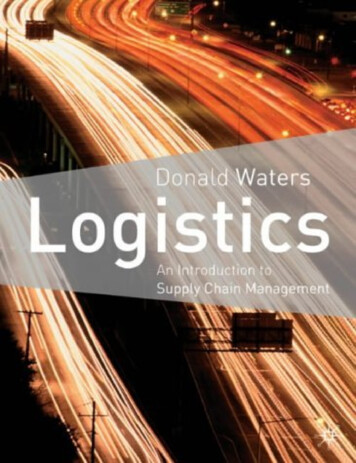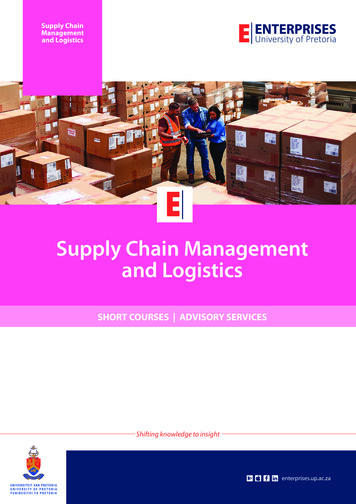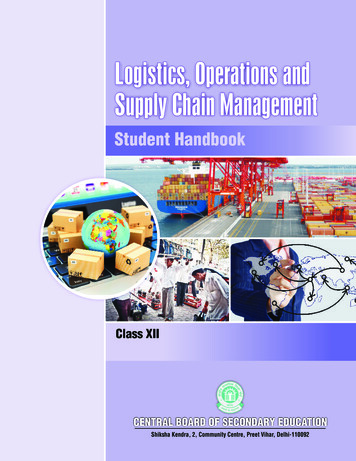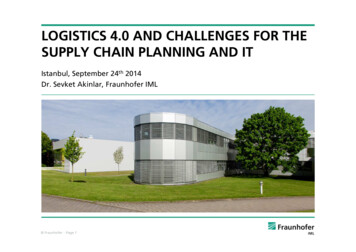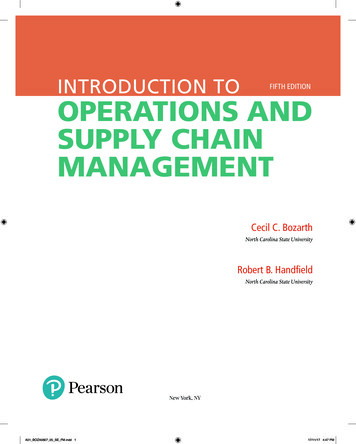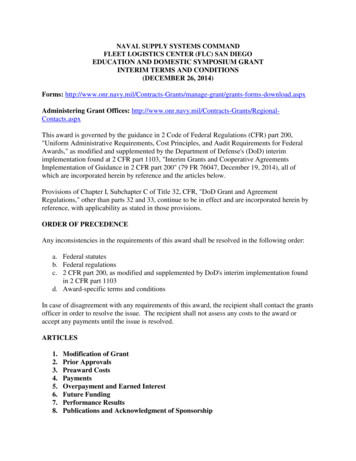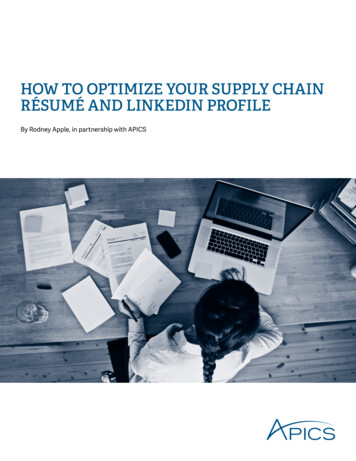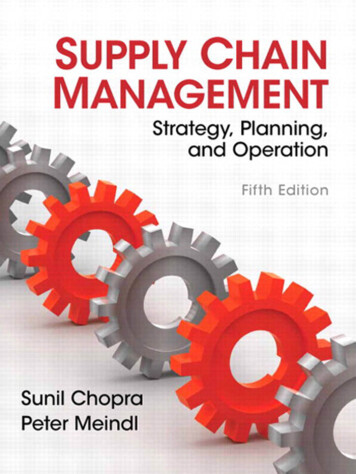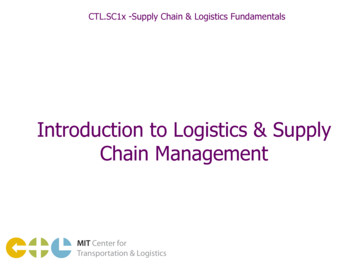
Transcription
CTL.SC1x -Supply Chain & Logistics FundamentalsIntroduction to Logistics & SupplyChain ManagementMIT Center forTransportation & Logistics
"Bananas". Licensed under Creative Commons Attribution-Share Alike 2.5 via Wikimedia Commons #mediaviewer/File:Bananas.jpg"Red High Heel Pumps" by Almighty1 at en.wikipedia - Own workTransferred from en.wikipedia. Licensed under Public domain via Wikimedia Commons http://commons.wikimedia.org/wiki/File:Red High Heel Pumps.jpg#mediaviewer/File:Red High Heel Pumps.jpg“Toyota IIA opened” by Hoikka1 Licensed under Creative Commons Attribution-Share Alike 3.0 Unported via Wikimedia commons –http://commons.wikimedia.org/wiki/File:Toyota IIA opened 2.jpg“Cement Bags” by StaraBlazkova Licensed under Creative Commons Attribution-Share Alike 3.0 Unported via Wikimedia commonsCTL.SC1x- Supply Chain and Logistics FundamentalsLesson: Introduction to Supply t bags.jpg2
Five Questions1.2.3.4.5.What is a supply chain?What are logistics and supply chain management?How should you view SCM?What are the challengesWhy should you care?CTL.SC1x - Supply Chain and Logistics FundamentalsLesson: Introduction to Supply Chains3
What is a Supply Chain?CTL.SC1x - Supply Chain and Logistics FundamentalsLesson: Introduction to Supply Chains4
What is a Supply Chain?Two or more parties linked by a flow of resources –typically material, information, and money – that ultimatelyfulfill a customer request.Information (order)Information (status)Material (delivery)Money (payment)CTL.SC1x - Supply Chain and Logistics FundamentalsLesson: Introduction to Supply Chains5
What is a supply chain?CTL.SC1x - Supply Chain and Logistics FundamentalsLesson: Introduction to Supply Chains6
What is a Supply SC1x - Supply Chain and Logistics FundamentalsLesson: Introduction to Supply Chains7
What is a Supply Chain? The primary purpose of a SC is to satisfy customer needs.n n n Only one source of revenue – the customerPayments between parties are just fund exchangesDivision of intra-SC payments are a function of power, marketconditions, etc. Supply Chains try to maximize the total value generatedn [What customer pays] – [Total effort expended to fulfill]CTL.SC1x - Supply Chain and Logistics FundamentalsLesson: Introduction to Supply Chains8
Logistics versus Supply Chain MgmtCTL.SC1x - Supply Chain and Logistics FundamentalsLesson: Introduction to Supply Chains9
What is Supply Chain Management?Logistics involves . . . “managing the flow of items, information, cashand ideas through the coordination of supply chain processes andthrough the strategic addition of place, period and pattern values.”MIT Center for Transportation & Logistics“Supply Chain Management deals with the management of materials,information, and financial flows in a network consisting of suppliers,manufacturers, distributors, and customers.“Stanford Supply Chain Forum“Call it distribution or logistics or supply chain management. Bywhatever name it is the sinuous, gritty, and cumbersome process bywhich companies move material, parts, and products to customers.”Fortune (1994)CTL.SC1x - Supply Chain and Logistics FundamentalsLesson: Introduction to Supply Chains10
Logistics vs. SCMAccording to the Council of Supply Chain Management Professionals . . .n n Logistics management is that part of supply chain management thatplans, implements, and controls the efficient, effective forward and reverseflow and storage of goods, services and related information between thepoint of origin and the point of consumption in order to meet customers'requirements.Supply chain management encompasses the planning andmanagement of all activities involved in sourcing and procurement,conversion, and all logistics management activities. Importantly, it alsoincludes coordination and collaboration with channel partners, which canbe suppliers, intermediaries, third party service providers, and customers.In essence, supply chain management integrates supply and demandmanagement within and across companies.Source: Used by permission, Council of Supply Chain Management Professionals, http://cscmp.org/.CTL.SC1x - Supply Chain and Logistics FundamentalsLesson: Introduction to Supply Chains11
Supply Chain ManagementPerspectivesCTL.SC1x - Supply Chain and Logistics FundamentalsLesson: Introduction to Supply Chains12
Supply Chain PerspectivesImage Source: Arntzen, B. MIT Center for Transportation & Logistics, Hi-Viz Research Project (2013)CTL.SC1x - Supply Chain and Logistics FundamentalsLesson: Introduction to Supply Chains13
Supply Chain x - Supply Chain and Logistics FundamentalsDistributorsLesson: Introduction to Supply Chains14
Process View of Supply ChainsCustomer Four Primary Cyclesn n n n Customer Order CycleCustomer Order CycleReplenishment cycleManufacturing CycleProcurement CycleRetailer Cycles Occur Between Stagesn Interactions differ at each stage Not every SC will have all 4 CyclesReplenishment CycleDistributorManufacturing CycleManufacturerProcurement CycleAdapted from Chopra & Meindl “Supply Chain Management”CTL.SC1x - Supply Chain and Logistics FundamentalsLesson: Introduction to Supply ChainsSupplier15
SupplierFirmSRM“source”Supplier RelationshipManagementn n n n SourcingNegotiationBuyingDesign and SupplyCollaborationISCM“make, move, store”Internal Supply ChainManagementn n n n Strategic PlanningDemand PlanningSupply PlanningFulfillmentCRM“sell”CustomerMacro Process (Software) PerspectiveCustomer RelationshipManagementn n n n MarketingSellingCall CentersOrder ManagementDifferent macro processes should be alignedn n Fall under different groups (Marketing-CRM, ManufacturingISCM, Purchasing-SRM)Forecasts, schedules, design, etc. should be coordinatedCTL.SC1x - Supply Chain and Logistics FundamentalsLesson: Introduction to Supply Chains16
Supply-Chain Operations Reference (SCOR) ModelPlanP1 Plan Supply ChainP3 Plan MakeSourceS1 Source Stocked ProductsS2 Source MTO ProductsS3 Source ETO ProductsP4 Plan DeliverP5 Plan ReturnsMakeDeliverD1 Deliver Stocked ProductsM1 Make-to-StockM2 Make-to-OrderM3 Engineer-to-OrderD2 Deliver MTO ProductsD3 Deliver ETO ProductsCustomersSuppliersP2 Plan SourceReturnDeliverReturnSourceEnableSource: Supply Chain CouncilCTL.SC1x - Supply Chain and Logistics FundamentalsLesson: Introduction to Supply Chains17
Traditional Functional Perspective Purchasing / Procurement Order Processingn n What to buy from whoCorporate vs Groupn n Inventory Controln n n How much to stock whereTrigger pointsReplenishment plan Warehousingn n n Storage, Mixing, Break bulkPick Pack and ShipWhat to stock where in WH Materials Handlingn n n How to move productPackaging, containerizationStorage layoutCTL.SC1x - Supply Chain and Logistics FundamentalsReceiving, Entry & StatusOrder Management Transportationn n n Inbound versus OutboundDomestic versus InternationalModal control (Rail, TL, LTL,Parcel, Air, etc.) Customer Servicen n GeographicProduct Line Specific Planning Groupn n n Facility LocationNetwork DesignDemand PlanningLesson: Introduction to Supply Chains18
Systems Perspectiveof Supply ChainsCTL.SC1x - Supply Chain and Logistics FundamentalsLesson: Introduction to Supply Chains19
Supply Chain as a System Take an Engineering Systems Perspectiven n n What is a variable and what is a constraint?Continuous expansion of decision variablesIncreases potential for improvement but increases bothcomplexity and coordination requirementsCustomer SvcTransportationOrder ProcessingMaterial HandlingInventory MgmtWarehousingPurchasingObjective: Deliver at lowest transport costVariable:w Select carrier to tender each load toConstraints:w Ship everything each dayw Must deliver within specified windowsCTL.SC1x - Supply Chain and Logistics FundamentalsLesson: Introduction to Supply Chains20
Supply Chain as a System Take an Engineering Systems Perspectiven n n What is a variable and what is a constraint?Continuous expansion of decision variablesIncreases potential for improvement but increases bothcomplexity and coordination requirementsCustomer SvcTransportationCTL.SC1x - Supply Chain and Logistics FundamentalsOrder ProcessingMaterial HandlingInventory MgmtWarehousingPurchasingObjective: Deliver at lowest total costVariables:w Select carrier to tender each load tow Select time windows to deliverw Select when to ship what from whereConstraints:w Deliver within negotiated time frameObjective: Deliver at lowest transport costVariables:w Select carrier to tender each load tow Select time windows to deliverConstraints:w Ship everything each dayLesson: Introduction to Supply Chains21
Supply Chain as a System Take an Engineering Systems Perspectiven n n What is a variable and what is a constraint?Continuous expansion of decision variablesIncreases potential for improvement but increases bothcomplexity and coordination requirementsCustomer SvcTransportationOrder ProcessingMaterial HandlingInventory MgmtWarehousingPurchasingManufacturingProduct DesignCTL.SC1x - Supply Chain and Logistics FundamentalsObjective:w Design, build, and deliver at lowest total costVariables:w Select carrier to tender each load tow Select time windows to deliverw Select when to ship what from wherew Select where to stock which form of productConstraints:w Deliver within negotiated time frameLesson: Introduction to Supply Chains22
Supply Chain as a System Take an Engineering Systems Perspectiven n n What is a variable and what is a constraint?Continuous expansion of decision variablesIncreases potential for improvement but increases bothcomplexity and coordination requirementsRetailerCTL.SC1x - Supply Chain and Logistics FundamentalsCustomer SvcTransportationOrder ProcessingMaterial HandlingInventory MgmtWarehousingPurchasingManufacturingProduct DesignSupplierWhy is this so hard to do?Objective:w Maximize on-shelf availabilityVariables:w Select carrier to tender each load tow Select time windows to deliverw Select when to ship what from wherew Select where to stock which form ofproductw Select contract relationshipsw Select who should control replenishmentw Which channel member should performwhich functionConstraints:w Total delivered cost to shelfLesson: Introduction to Supply Chains23
What are the major challenges?(Why is it so hard?)CTL.SC1x - Supply Chain and Logistics FundamentalsLesson: Introduction to Supply Chains24
Why is it so difficult? 1/2 Metrics – How do you measure a system?n n Trade-off of Breadth vs. Validity of metricsOutcome Based Logistics - Perfect order, Perfect Shelf Politics and Power of Players - Who wins?n n Mom & Pop Shop versus Mega-StoresMega Retailers vs. Mega CPG Manufacturers Visibility – Who can see what and how quickly?n n n Data are stored separatelyAll parties do not have equal access to dataMassive data Shared & accessible informationCTL.SC1x - Supply Chain and Logistics FundamentalsLesson: Introduction to Supply Chains25
Why is it so difficult? 2/2 Uncertainty - Who knows what is going to happen?n n n n Variable demand of product (shorter lifecycles)Variable manufacturing yieldUnreliable sourcing of raw materialsInconsistent transit lead times Increased complexity – Why is it getting harder?n n n Exploding number of Stock Keeping Units (SKUs)Higher and diverging customer demandsNew & merging channels (Omni-Channel) Global operations – Why don’t we ever close?n n Most firms source & sell across globeMultiple regions, time zones, languages, & culturesCTL.SC1x - Supply Chain and Logistics FundamentalsLesson: Introduction to Supply Chains26
Why do we care?CTL.SC1x - Supply Chain and Logistics FundamentalsLesson: Introduction to Supply Chains27
Why do we care? Supply Chains . . .n n n Span the globe and cannot be managed as an isolated function,Have become critical to any organization’s operations, andConnect functions, divisions, and business units within a firmas well as across firms.Evolved into being both a Bridge and a Shock AbsorberBy Wsvan; cropped by Beyond My Ken (talk) 01:29, 14 October 2013 (UTC) (Own work) [GFDL (http://www.gnu.org/copyleft/fdl.html) or CC-BY-SA-3.0 (http://commons.wikimedia.org/wiki/File:Leonard P. Zakim Bunker Hill Bridge - Boston, MA.jpg"Mini Shocks" by Avsar Aras - Own work. Licensed under Creative Commons Attribution-Share Alike 3.0 via Wikimedia Commons - http://commons.wikimedia.org/wiki/CTL.SC1x- Supply Chain and Logistics FundamentalsLesson: Introduction to Supply ChainsFile:Mini Shocks.JPG#mediaviewer/File:Mini Shocks.JPG28
Example: Variability of #2 Diesel Pricing4.84.6On Highway Price of #2 Diesel ( /gallon)4.44.243.83.63.43.232.82.62.42.22Oct-06 Apr-07 Oct-07 Apr-08 Oct-08 Apr-09 Oct-09 Apr-10 Oct-10 Apr-11 Oct-11 Apr-12 Oct-12 Apr-13 Oct-13 May-14 Nov-14Data Source: U.S. Energy Information Administration, http://www.eia.gov/petroleum/gasdiesel/diesel proc-methods.cfmCTL.SC1x - Supply Chain and Logistics FundamentalsLesson: Introduction to Supply Chains29
Logistics Costs per GDP16.0%Percentage of US CostTransCost( T)( B)( 0%4.0%2.0%19801985199019952000200520102015YearUS Inventory Holding CostUS Transportation CostTotal US Logistics CostData Sources: Council of Supply Chain Management (2014) 25th Annual State of Logistics ReportCTL.SC1x - Supply Chain and Logistics FundamentalsLesson: Introduction to Supply Chains30
Still, why do we care?FunctionalLogisticsSupply ChainKe
“Supply Chain Management deals with the management of materials, information, and financial flows in a network consisting of suppliers, manufacturers

